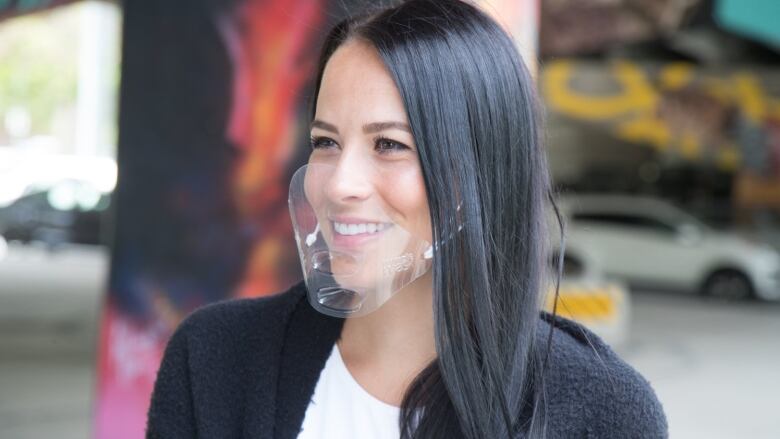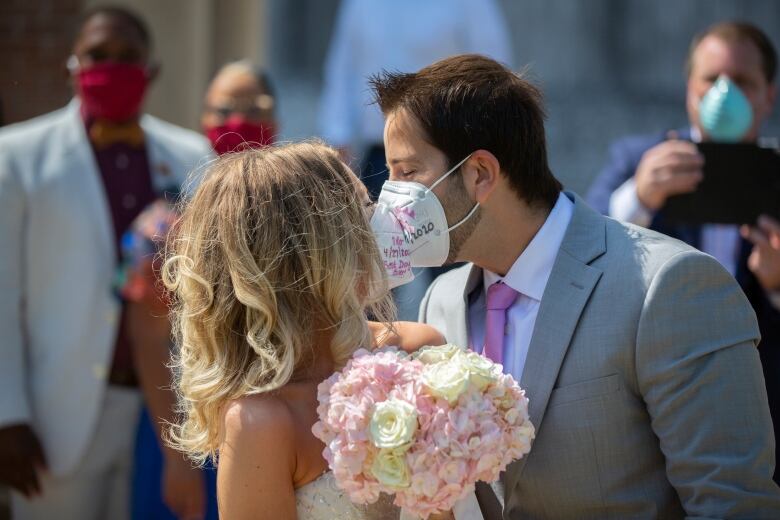Can I use a mouth shield instead of a mask? Your COVID-19 questions answered
From mouth shields to dancing and hugging safely. Heres what youre asking us today

The information in this article was current at the time of publishing, but guidelines and advice can change quickly. Check with your local public health unit for the most-current guidance, and find the latest COVID-19 news on our website.
We're taking on your questions about the pandemic. Send them to us via email at COVID@cbc.ca, and we'll answer as many as we can. We're putting some of your questions to the experts during The National and on CBC News Network. We're also publishing them here on our website. You're keeping us busy. So far, we've received more than 52,000 emails from across Canada and beyond.
Can mouth shields replace cloth masks?
Mask questions continue to be a major theme in our inbox, but this week, a bunch of you are writing to ask us about mouth shields. The plastic guards cover the lower half of a person's face and are marketed for stopping the spit of food-service workers.
Tal S. is wondering if they can be worn instead of non-medical masks.
The experts say no.
"I don't think they're a really good alternative at all," said Dr. Susy Hota, medical director for infection prevention and control at the University Health Network in Toronto, in a recent interview on The National.
"These are developed for the food-service industry, and they're really not studied or designed for this purpose at all."
Of course, the purpose of wearing non-medical face coverings, according to public health officials, is to protect others from the droplets spewing from your mouth and nose.
There is also evidence that non-medical masks may offer some protection for the wearer, too. Butbecause mouth shields are not tight fitting and are open at the top, Hota said,there are "lots of opportunities for droplets to get in."
"I would avoid using them," she said.
Colin Furness, an infection control epidemiologist and assistant professor at the University of Toronto, also said he's "not a fan" because mouth shields don't collect droplets like a mask would.
"Cloth masks actually get damp," Furness said in an email. "But I'm guessing [shields] don't have rivulets of water running down them, and that would be because the droplets aren't staying."
Instead, he explained, the droplets are just forced sideways around the shield.
"Full face shields have the same problem," Furness said. Read more about the issues with face shields here.
I'm hosting an outdoor wedding. Is it OK to dance?
With the gradual lifting of limits on the size of gatherings, Canadians are asking us about good practices for get-togethers.
Joanne L. told us she's hosting a backyard wedding at her home in Aurora, Ont., but she wasn't sure if dancing was advisable.
The answer is: It's complicated.

Dancing, like singing, is one of the activities that is still considered to be higher risk. In some settings, like in restaurants and bars in the province of Ontario, for example, they fall under explicit restrictions and regulations.
For example, performers must:
- Work for the establishment.
- Maintain a physical distance of at least two metres from every other person.
- Be separated from others with a physical barrier, like plexiglass.
However, the Ontario Ministry of Health explained in an email that those regulations don't apply to events outside of restaurants and bars.
That means dancing is allowed at your backyard wedding, though distancing and gathering limits still apply. Outdoors, that's up to 50 people for the service or ceremonyand up to 100 people for the reception.
But just because it's allowed doesn't mean it's without risk. It's particularly risky, Furness said, because people tend to get close and start breathing harder, "which means expelling more droplets and expelling them further."
Dr. Anand Kumar, a professor of medicine at the University of Manitoba, added that loud speech, shouting and singing also increase the potential distance of droplet spread. He recommended that guests wear masks "particularly if [there is] loud music which would force participants to shout."
Health Canada also advises wearing non-medical masks when distancing is difficult. Furness suggested painting big circles on the dance floor, two metres apart, to keeppeople from getting too close. But he warned that things could become challenging when guests start cutting loose.
"The problem with a wedding is that it's not certain that people would keep their mask onor their distance from each other," he said.
That said, being outdoors would offer "excellent protection," Furness said, "and either really hot weather or a firm breeze is even more protective." But the benefits of being outdoors might be reducedif you've erected a tent.
If it has open sides with a breeze coming through, Furness said he'd consider that "outdoors." But if it has walls, it's indoors.
"I did attend one family dinner in a tent with sides earlier this month, and it was easily the riskiest thing I have done since COVID began," he said. "I wouldn't do that again for any reason."
Is there a safer way to hug?
It's not just weddings that makepeople want to get close. The pandemic has left many Canadians longing to wrap their arms around their friends and family.
But what about people not inside your bubble? Carol F. wrote to us to ask if there is a safer way to squeeze them.
First, it's important to note that public health officials are still advising physical distancing from people not in your household or bubble. Canada's Public Health Agency is suggesting"friendly" waves instead of hugs and kisses, especially with people who are at higher risk of experiencing a severe illness or death due to COVID-19. But whatif you still want to risk it?
"It's a difficult one to call," Dr. Lynora Saxinger, an infectious disease physician at the University of Alberta in Edmonton, saidin an interview on The National.
"We know that routine closeness can lead to increased transmission."
Hugs, for example,should be reserved as a "special occasion," she said.

If you were to give someone a special occasion hug, brief contact while wearing masks and with your faces turned away "would be the safest way to do it," she said.
It might not be a bad idea to hold your breath as well, said CBC News medical contributor Dr. Peter Lin.
Hold your breath before "going in for the hug," he told CBC News Network. "The virus is not moving at that point."
Lin said he even recommends this move to elderly grandparents.
"Once the hug is over, hold your breath again as they pull away, and the virus can't be breathed into your system."
That said, physical embraces aren't without risk, and that might increase when the grandkids go back to school.
"Some people might say, 'You know what. I'm still OKhugging my grandchildren,'" said Dr. Isaac Bogoch, infectious disease specialist at Toronto General Hospital.
"Other people might say, 'The risk is too high, and I'm not going to do this anymore, and we'll get our hugs in before school starts,'" he said.
Bogoch advised keeping an eye on community transmission in your area. If rates go up, you may want to pump the brakes on close activity with the little ones. We looked at how grandparents might mitigate the back-to-school risks in a previous FAQ.













_(720p).jpg)


 OFFICIAL HD MUSIC VIDEO.jpg)
.jpg)



























































































